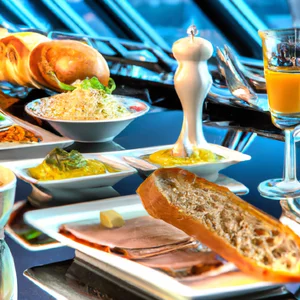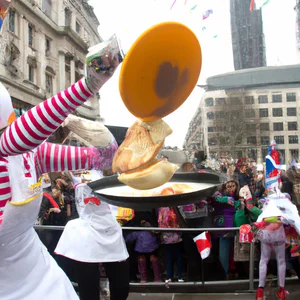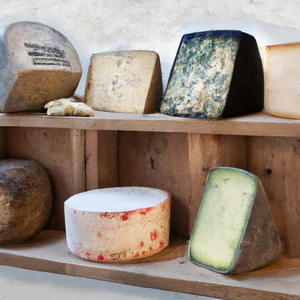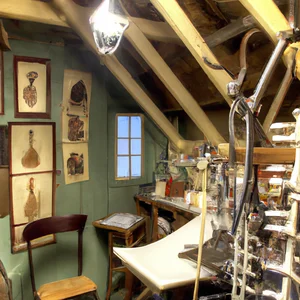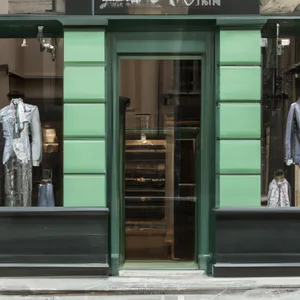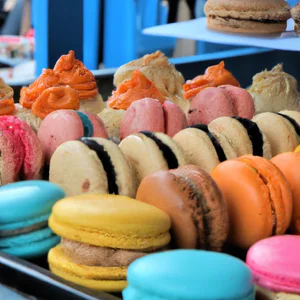Book your experience
Museum of Brands: a century of British advertising and packaging
The Museum of Brands, guys, is a really cool place! Imagine taking a time travel trip, but instead of a time machine, you just have a ton of old ads and packaging to explore. It’s like every object in there tells a story, and believe me, there are a lot of stories to discover!
We’re in the UK, right? Well, this museum is a real treasure of a century of British advertising history. Think about all those product labels you’ve probably seen around. Some are super famous, others you may not even know. But, you know, that’s the beauty of it!
When I went there, I saw ads from the 1960s that looked like they came out of a vintage movie. There was an advertisement for an ice cream that looked so tempting, it almost made me want to buy a cone, even though it was January and it was freezing cold outside. And then, speaking of packaging, there was a bottle of Coca-Cola that looked like a work of art! I mean, it’s incredible how a simple object can make us feel nostalgic, right?
Of course, it’s not just a museum for those who love advertising. It is a real journey into popular culture, because through these objects you can understand how society has changed over time. I think it’s fascinating to see how fashions, tastes and values have evolved. Maybe I’m not 100% sure, but it seems to me that every generation has its own way of expressing itself, and advertising is a bit like a mirror of all this.
And then, let’s talk about anecdotes! Once upon a time, during a visit, I met an elderly lady who remembered when she was a child and she ran to buy sweets from a little shop under her house. Her stories made me understand how certain brands can be linked to the sweetest memories of our childhood. It’s nice to think that behind every brand there are people, stories and dreams.
In essence, the Museum of Brands is not just a place where you look, but it is a real journey into a world that, sometimes, we forget to explore. If you happen to be in the area, drop by! You won’t regret it, and who knows, maybe you’ll go home with some more memories and a smile.
Museum of Brands: the evolution of British packaging
A journey through time through packaging
When I walked through the doors of the Museum of Brands in London, I was immediately struck by an unexpected olfactory experience: the familiar aroma of Pears soap, which took me back in time to when, as a child, I helped my grandmother tidy up her household products. This feeling of nostalgia is just a taste of what this unique museum offers, where British packaging tells a story of innovation, creativity and cultural change across the course of a century.
The evolution of British packaging
The museum houses an extraordinary collection of over 12,000 pieces of packaging, tracing the evolution of brands and their designs. From the elegant glass bottles of the Victorian era to the vibrant packaging of the 1980s, each item represents a significant step in the history of British marketing. It’s not just a question of aesthetics: packaging reflects changes in consumer tastes, technological innovations and the social dynamics of the time.
For those interested in exploring further, the museum also offers workshops that teach packaging design techniques, to discover how visual and material choices can influence product perception.
An insider tip
If you want a truly unique experience, try your hand at visiting the museum during one of their special events, like the “Packaged Design Challenge,” where participants can try their hand at creating their own packaging. This event is not only an opportunity to learn, but also to interact with designers and enthusiasts in the field, making your visit even more memorable.
The cultural impact of packaging
Packaging in the UK is not just a means of containing products; it has become a reflection of British culture. For example, in the post-war period, packaging underwent significant transformations to adapt to new regulations and the needs of a nation undergoing reconstruction. Brands have had to innovate, often relying on recycled materials, thus anticipating current sustainability practices in design.
Sustainability and responsibility
In an age where sustainability has become a priority, the Museum of Brands is committed to educating visitors on the importance of responsible design. Through exhibitions and events, the museum promotes the use of eco-friendly materials and the adoption of sustainable practices in the packaging sector.
Soak up the atmosphere
Walking through the exhibitions, let yourself be enveloped by the bright colors and nostalgic logos of iconic brands. Every corner of the museum is a window into a bygone era, inviting you to reflect on how packaging has shaped our everyday experiences. It is a fascinating journey that stimulates the senses and curiosity.
Activities not to be missed
Don’t forget to take a break in the museum café, where you can enjoy some vintage snacks and drinks, a delicious way to end your visit. Try classics like the Tango or a Barley Sugar, which not only bring back memories but also offer a taste of British pop culture.
Debunking common myths
A common misconception is that packaging is just a matter of aesthetics. In reality, packaging design is crucial to the functionality and preservation of the product, as well as playing a key role in marketing and advertising. It’s interesting to see how many of the techniques used today are rooted in practices developed decades ago.
A final reflection
Visit the Museum of Brands to discover not only the brands that have shaped British history, but also to consider how packaging impacts our daily lives. Which brand story impressed you the most? Your experience may push you to look at the packaging you use every day with new eyes.
A journey through the history of advertising
A personal experience
I still remember the moment I walked through the doors of London’s Advertising Museum. An air of nostalgia and innovation mingled as my eyes fell on vintage posters and commercials that told stories of a bygone era. One particular campaign from the famous chocolate brand Cadbury struck a chord with me: its slogan, “Taste the Joy,” still resonates today, evoking childhood memories and shared moments of happiness. This journey through time made me understand how profoundly advertising influences our culture and our behaviors.
Practical information
For those who want to immerse themselves in the history of British advertising, the Museum of Advertising in London is an unmissable stop. The museum offers interactive exhibits and a collection of more than 10,000 advertising artifacts, from the 19th century to the present day. The visit is recommended during the weekend, when special events and workshops for families are also held. Don’t forget to check the official website for updated timetables and any necessary reservations.
Unconventional advice
A little-known tip is to take one of the nightly guided tours, where industry experts share exclusive anecdotes and behind-the-scenes stories of the most iconic advertising campaigns. These tours, in addition to offering a unique perspective, also allow you to explore the city in a new light, literally and figuratively.
The cultural impact
Advertising is not just a means of selling products, but a reflection of social and cultural changes. From the countryside “Keep Calm and Carry On” during the Second World War, which encouraged the British people to persevere, to recent advertising movements embracing diversity and inclusion, advertising has played a crucial role in shaping the perceptions and ideologies of British company.
Responsible tourism practices
Many museums and galleries in London are adopting sustainable tourism practices, such as using recycled materials for exhibitions and promoting events that raise public awareness of environmental issues. Choosing to visit these institutions not only enriches your cultural experience, but also supports more responsible tourism.
An engaging atmosphere
Walking among the exhibitions, it is easy to get carried away by a whirlwind of colours, sounds and scents evocative of bygone eras. Classic film posters, vintage product packaging and advertising jingles envelop you, transporting you on a sensorial journey that stimulates curiosity and imagination.
Activities to try
If you want to learn more about advertising, take part in a slogan creation or advertising design workshop, often organized by the museum. These events offer a unique opportunity to explore your creativity and better understand the techniques used by industry professionals.
Myths to dispel
A common misconception is that advertising is always misleading. In reality, many advertising campaigns arise from a strong desire to communicate authentic values and create emotional connections with the public. Advertising can be an art form that reflects society, rather than just a sales strategy.
A final reflection
The history of advertising is a window into social and cultural change, reflecting the aspirations and fears of every era. As you explore the museum, ask yourself: How do advertising messages influence our daily choices? This reflection could open a new chapter in your understanding of British culture and its impact on the world.
Interactive experiences: engage your senses
A sensorial journey between history and innovation
I still remember the first moment I crossed the threshold of an interactive museum dedicated to advertising in London. A world of colours, sounds and smells enveloped me, making the history of British advertising not only visible, but vividly tangible. As I explored the installations, I was able to manipulate old printing presses, listen to historic advertising jingles, and even smell fragrances associated with iconic campaigns. This type of active involvement transforms the visit into a memorable experience, where history comes to life through the senses.
Practical information
If you want a similar experience, I recommend visiting the Museum of Brands in Notting Hill. This unique space houses a collection of over 12,000 packaging and advertising items, chronicling the evolution of British branding from the 19th century to today. The museum also offers hands-on workshops where visitors can create their own packaging, an activity that stimulates creativity and invites reflection on the importance of design. For more details, visit their official website: Museum of Brands.
An insider tip
Here’s a little-known tip: try to visit the museum during one of their special events, such as “Creativity in Advertising” evenings. These events offer the opportunity to interact with industry experts and participate in exclusive workshops, where you can learn the techniques used by professionals to create memorable advertising campaigns.
Cultural and historical impact
British advertising has had a profound impact not only on local, but also global culture. Over the years, brands like Cadbury and Oxo have used innovative advertising techniques to capture the public’s imagination, marking eras and influencing the way products are perceived. These interactive experiences not only educate, but also invite reflection on how consumption choices have been shaped over time.
Sustainability in design
In an era where sustainability is key, the museum encourages responsible practices, showing how packaging can evolve towards greener solutions. Exhibitions often include examples of brands that have adopted recycled or biodegradable materials, highlighting the importance of a responsible future in design.
Soak up the atmosphere
Imagine walking among shelves full of vintage items, with the soft lights creating an almost nostalgic atmosphere. Each object tells a story, and the scent of ink and paper transports you to a bygone era, where advertising was an ever-evolving art. This is a place where the past and present intertwine, inviting you to reflect on how advertising has shaped our lives.
An activity worth trying
Don’t miss the opportunity to participate in a packaging creation workshop. Not only will you have the opportunity to express your creativity, but you will also be able to take home a unique piece that represents your vision. It’s a perfect way to end your visit.
Myths and misconceptions
A common misconception is that advertising is just a form of manipulation; however, it is also a powerful tool for communication and cultural connection. Through interactive experiences, it is possible to see how advertising can reflect a society’s values and desires, rather than just influence them.
Final reflection
After exploring the interactive experiences at the Museum of Brands, I invite you to reflect: how do the adverts we consume every day impact our identities and behaviours? Consider this as you immerse yourself in the vibrant and fascinating world of British advertising.
Discover the iconic brands that marked an era
A personal journey into the world of British brands
I still remember with vivid nostalgia the first time I walked along Oxford Street in London. As my eyes wandered among the glittering windows, one shop in particular caught my attention: a vintage boutique dedicated to British brands of yesteryear. The smell of leather and aged cotton mixed with the scent of tea and biscuits from a nearby café. Here, among clothes and accessories, I discovered the stories of iconic brands such as Burberry and Barbour, which have shaped not only British fashion, but also global popular culture.
Brands that have made history
British brands are witness to a cultural evolution that dates back centuries. Cadbury, for example, is not just a name known for its chocolate; it is a symbol of innovation and community, born in 1824, when John Cadbury began selling tea and coffee in Birmingham. Today, the famous milk chocolate represents a deep link with the past and traditions of Great Britain.
Additionally, brands such as Royal Doulton have taken British ceramic craftsmanship to levels of international excellence. Their importance isn’t just limited to aesthetics: they speak to a time when British industry dominated the global market, reflecting values of quality and design that endure to this day.
An insider tip: treasure hunting
If you want to bring home a piece of history, don’t limit yourself to high street stores. Pop into flea markets or antique shops in less touristy neighborhoods, like Camden or Portobello Road. Here, you may find unique pieces of memorabilia from iconic brands at affordable prices. Often, sellers can share fascinating stories about each object, making your experience even more authentic.
Cultural and historical impact
The influence of British brands extends far beyond their commercial value. These brands have helped define the UK’s cultural identity, bringing a sense of national pride. Brands like Aston Martin and Mini aren’t just cars; they represent a way of life, an era of engineering innovation and iconic design that has fascinated generations.
Sustainability and responsibility in design
In recent years, many British brands have adopted sustainable practices, recognizing the importance of a responsible future. ** Vivienne Westwood **, for example, is known not only for her bold style, but also for her commitment to sustainability. Buying from brands that promote sustainability not only enriches your travel experience, but also helps support the local community and the environment.
Activities not to be missed
To fully immerse yourself in the culture of British brands, visit the British Museum, where you can explore exhibitions dedicated to design and fashion. Another unmissable experience is the tour of Savile Row, famous for its bespoke tailoring, where you can observe the art of creating high-end suits up close.
Myths to dispel
A common misconception is that British brands are exclusively the preserve of the elite. In reality, many of these brands have humble beginnings and have evolved to embrace a global customer base. The idea that only luxury products define the value of a brand is limiting; the true essence lies in the stories and traditions that they bring with them.
Final reflection
As you explore the landscape of iconic British brands, ask yourself: which of these brands’ stories resonates with you the most? Every brand has a soul, a message and a secret to share. Be inspired and discover how the past continues to influence the present in this fascinating corner of the world.
Guided tour: an insider in the world of advertising
Imagine finding yourself in a small gallery in London, surrounded by vintage posters and commercials that tell stories of an ever-evolving society. On my first visit to an exhibition dedicated to British advertising, I was struck by the passion and creativity that permeates every corner. A passionate curator has shared surprising anecdotes about how advertising campaigns have influenced and, in some cases, shaped British culture. This is just a taste of what you can discover by taking a guided tour with an insider into the world of advertising.
A journey through time through advertising
Guided tours dedicated to advertising offer a unique opportunity to explore the origins and evolution of this sector. Through fascinating stories, you’ll discover how iconic brands, from Cadbury to British Airways, have used creativity to connect with audiences. Local guides, often experts in the fields of marketing and communications, share up-to-date information, making the experience engaging and educational.
A little-known tip: Ask your guide to show you lesser-known ads that have had a significant impact. These hidden gems often reveal the skill and ingenuity of marketers of the time, leading you to think about how advertising can influence social trends and consumer behaviors.
The cultural impact of advertising
Advertising is not just about sales; it is a reflection of the society we live in. From the Victorian era to the present day, British advertising campaigns have addressed issues such as war, technological progress and social change. This historical aspect is fundamental to understanding the context in which each advertisement was created. Guided tours will allow you to explore how advertising has not only sold products, but also shaped cultural opinions and values.
Sustainability and responsibility
Today, the topic of sustainability is at the center of attention in the advertising world. Many brands are adopting responsible and sustainable practices, and tours often include discussions on how the industry is evolving to address environmental challenges. Finding out how legacy brands are trying to adapt to climate change can give you a new perspective on what it means to be a conscious consumer in an ever-changing world.
An activity not to be missed
Don’t miss the chance to attend a hands-on advertising workshop at one of the local galleries. Here, you can try your hand at creating your own advertising campaign, using techniques and styles that you learned during the guided tour. This interactive experience will not only enrich your understanding of the industry, but will also leave you with a tangible memory of your adventure.
Final reflections
In a world where we are constantly bombarded with advertising messages, take a moment to reflect on how they may influence our daily decisions. What was the last advertisement that impressed you? What made you consider a product? The next time you are faced with an advertisement, you may wonder what story lies behind it and what impact it may have on culture and society.
Immerse yourself in the fascinating world of British advertising and discover how a simple message can transform into a powerful tool for connection and change.
Sustainability in design: a responsible future
I clearly remember the moment I walked along the streets of Brighton, surrounded by crisp sea air and surrounded by shops displaying eco-friendly products. A small design shop caught my attention: its windows were full of objects made from recycled materials and biodegradable packaging. As I examined a beautiful notebook made from recycled paper, the owner told me about his passion for sustainability and how each purchase was a step towards a better future. That day opened my eyes to the importance of responsible design and the positive impact it can have on our environment.
The evolution of sustainable packaging
In recent years, British packaging has undergone a radical transformation, shifting focus away from traditional materials, such as plastic, towards greener alternatives. According to a report by the Waste and Resources Action Program (WRAP), the UK has seen a significant increase in the use of recyclable and compostable packaging. Iconic brands such as Coca-Cola and Unilever have launched initiatives to reduce single-use plastic, encouraging consumers to choose more sustainable options.
A little-known tip
If you are passionate about sustainable design, don’t miss local markets, such as Greenwich Market, where local artisans and designers offer unique products made from recycled materials. Here you may find more unique and authentic items than in conventional shops, and help support the local economy.
Cultural and historical impact
The movement towards sustainability in design is not only a response to environmental challenges, but also a reflection of a broader cultural shift. Britons are increasingly aware of the impact of their everyday choices, and this is reflected in the brands they choose to support. Sustainability has become a core value that permeates design culture, influencing everything from consumer products to architecture.
Responsible tourism practices
When you explore destinations and shops, tries to adopt responsible tourism practices. Opt to purchase from local businesses that use sustainable methods and seek out experiences that promote environmental awareness. Many museums and galleries in London, such as the Victoria and Albert Museum, have exhibitions dedicated to sustainable design, offering interesting insights into how design can contribute to a better future.
An experience worth trying
For an immersive experience, join a sustainable design workshop. Many creative spaces in London offer courses where you can learn to create things using recycled materials. Not only will you learn new skills, but you will also have the opportunity to meet people who share your passion for sustainability.
Common myths
A common misconception is that sustainable products are always more expensive or of low quality. In fact, many emerging brands are proving that sustainable design can be accessible and high-quality, challenging the idea that cost should be a barrier to those who want to live more responsibly.
In conclusion, sustainability in design is not just a trend; it is a movement that is shaping the future of our cities and our daily choices. What are your thoughts on how we can all contribute to a more sustainable world through our consumer choices?
Historical curiosities: the power of marketing at war
A thought-provoking anecdote
I vividly remember my visit to a museum dedicated to the history of advertising in the heart of London. While admiring a World War I recruiting poster, I found myself immersed in deep reflection on how marketing can influence social and political choices. That catchy phrase, “You are the man we are looking for!”, not only inspired thousands of men to join the army, but also marked a time when words had the power to change the course of history.
Practical and up-to-date information
The history of wartime marketing is full of fascinating examples. During the First and Second World Wars, British advertising campaigns evolved dramatically, using powerful images and evocative slogans to mobilize the masses and raise funds. A great starting point for exploring this theme is the Imperial War Museum, which houses a large collection of publicity materials and historical propaganda.
Unconventional advice
An industry insider told me a little-known fact: During World War II, British advertisers used cutting-edge psychological techniques to create communications campaigns that not only informed, but also inspired a strong sense of belonging and duty. In particular, the “Keep Calm and Carry On” poster was originally designed to raise morale in the event of air attacks, but its evocative power only re-emerged decades later, becoming a symbol of British resilience.
Cultural and historical impact
The impact of wartime advertising goes beyond simple recruitment. Advertising campaigns have helped shape national identity, creating a sense of unity during times of crisis. These messages not only mobilized human resources, but also encouraged the population to support the war efforts through purchases of consumer goods and donations. Propaganda has therefore played a crucial role in keeping hope and determination alive in difficult times.
Sustainable tourism practices
When exploring the history of advertising in war, it is important to do so responsibly. Many museums and history centers now offer guided tours that not only inform, but also encourage critical reflection on war messages and their relevance in the modern context. Consider participating in organized tours that promote dialogue and historical awareness rather than simply presenting facts and figures.
An activity worth trying
I recommend you visit the Museum of Brands, located in London. Here you will be able to see how marketing has evolved over time, exploring advertising campaigns linked to wars, but also to social changes. Don’t forget to join one of their interactive experiences, where you can test your creativity in designing an advertising poster!
Myths and misconceptions
A common misconception is that wartime advertising is just a matter of recruitment and propaganda. In reality, advertising has played a much broader role, influencing cultural and social perceptions and contributing to an entire economic ecosystem during conflicts. Understanding this can greatly enrich your travel experience.
Final reflection
As we reflect on how marketing has influenced the course of history, a question arises: How can we use the lessons of the past to meet the challenges of the present? Advertising has the power to unite and inspire; How can we ensure it is used for positive purposes in our modern world?
Family Activities: Fun for all ages
Imagine entering a museum where every corner tells a story, a place where the past is presented so vividly that visitors feel as if they are walking between eras. During my visit to the Museum of Brands, I witnessed a scene that captured my heart: a family gathered around an interactive table, immersed in a game of creating labels for vintage products. The parents, with eyes shining with nostalgia, and the children, fascinated by the colors and shapes, laughed together as they explored the world of packaging. This is the type of experience that makes the museum a great family destination.
An experience for all ages
The Museum of Brands is designed to be accessible and engaging for all age groups. In addition to the various exhibition itineraries that trace the evolution of British packaging, there are practical activities that stimulate the creativity of young people. For example, the design workshop offers children the chance to create their own packaging for an imaginary product, encouraging artistic expression and understanding of design.
A unique tip
If you want an even more memorable experience, ask museum staff if there are any special events or activities planned during your visit. Often, they organize pop-up workshops or school trips that can further enrich your experience. Museum insiders know that these occasions offer a unique opportunity to interact with branding and design experts.
The cultural impact of packaging
Packaging is not just a wrapper; it is a reflection of the culture and time in which it was created. From the plastic of the 1960s to the sustainable materials of today, the way products are packaged tells stories of innovation, social change and adaptations to consumer needs. The Museum of Brands highlights these transformations, allowing visitors to understand how design choices have influenced purchasing habits and, ultimately, British culture.
Sustainability and responsibility
In the current context, the museum is committed to promoting sustainable design practices, educating visitors on the importance of responsible packaging. During your visit, you may discover how some historic brands are adapting to reduce their environmental impact, making the museum not only a place of learning, but also an enabler of positive change.
An activity worth trying
Don’t forget to visit the museum shop, where you can find a selection of educational games and kits family design. Buying a souvenir that stimulates your children’s creativity can be a way to extend the experience at home too.
Myths to dispel
A common misconception is that museums are boring or uninteractive, but the Museum of Brands challenges this perception. Its engaging activities and hands-on approach ensure that families not only learn, but have fun doing it.
Final reflection
As you explore the Museum of Brands, ask yourself: What impact has packaging had on your daily life? How do the images and messages around us shape our choices and our identity? This museum is not only a journey through time, but also an opportunity to reflect on how advertising and design influence our lives in ways we may never consider.
Explore the evolution of British packaging at the Museum of Brands
A journey through time through vintage packaging
When you cross the threshold of the Museum of Brands in London, it’s as if you’re standing in front of a time portal. I still remember my first visit: a feeling of wonder enveloped me as I found myself surrounded by packages of products that I had only seen in the stories told by my parents. Each package tells a story, an era, a culture. The variety of materials, colors and designs used in British packaging over the century makes you think about how marketing and trends have evolved over time.
From nostalgia to collecting
If you are a collector enthusiast, the museum offers a unique opportunity to discover how to start collecting local memorabilia. It’s not just a question of objects, but of emotions and stories linked to iconic brands. You may not know it, but many of the boxes you’ll see are now considered collector’s items, and some visitors have even built entire collections from what they’ve seen here. Insider’s advice? Start searching the flea markets and vintage shops in the area: you might discover some real treasures!
The cultural impact of packaging
Packaging is not just a wrapper; represents changing tastes and social norms. Let’s think about how brands have had to adapt during difficult historical periods, such as wars, to remain relevant. Each package you look at at the museum offers an insight into British society, revealing how consumer preferences have changed over time. The colors and materials reflect not only the fashions, but also the values and aspirations of an era.
Towards a sustainable future
In the current context, it is important to also consider the aspect of sustainability in packaging design. The museum not only celebrates the past, but also invites reflection on how brands are addressing modern challenges through more responsible practices. The transition towards recyclable materials and eco-friendly design is becoming increasingly central, and the Museum of Brands continues this conversation, making it accessible to all visitors.
An experience not to be missed
If you are in London, don’t miss the opportunity to visit the Museum of Brands. I recommend you dedicate at least a couple of hours to this immersive experience. You will discover that packaging, often considered banal or negligible, is actually a fascinating element of our collective history. And, who knows, you might return home with a new interest in collecting!
The next time you open a package of a product you love, stop for a moment to think: what stories and what changes are behind that simple packaging? You will be surprised to discover how rich the world of packaging can be and how much it can say about our culture.
Taste the past: vintage food and drinks to try
A journey into the flavors of an era
I remember the moment I took my first bite of an artisanal ‘Pork Pie’ in a small country pub in the heart of England. The golden crust, crispy at the right point, contained a tasty and spicy meat filling, a real dive into the British gastronomic past. This traditional dish, a symbol of an era when food was prepared with fresh ingredients and artisanal methods, is just one of the many culinary treasures worth discovering.
A historic culinary offering
Today, visitors can explore the world of vintage food at numerous markets and restaurants that celebrate historic British cuisine. Places such as London’s Borough Market offer a selection of vintage food products, from aged cheeses to traditional desserts such as the ‘Spotted Dick’. According to the market’s official website, many of the vendors are committed to preserving authentic recipes and production methods passed down for generations.
An insider tip
A little-known secret is that, for an authentic experience, you should look for “pop-up restaurants” that offer vintage themed nights. These events, often organized by local chefs, present menus inspired by historical recipes, allowing you to savor the past in a convivial and often informal atmosphere. Don’t forget to ask about the ingredients: many of these restaurants use local and sustainable products, thus contributing to responsible tourism.
A fascinating cultural panorama
British cuisine has a profound cultural impact, reflecting the country’s traditions and historical influences. During the two world wars, for example, rationing forced families to reinvent traditional dishes, creating new flavor combinations. This spirit of resilience is still reflected today in many vintage recipes, which tell stories of ingenuity and creativity.
Sustainability and tradition
Many restaurants that celebrate vintage food are also attentive to sustainability. They opt for seasonal and local ingredients, reducing environmental impact and supporting local producers. This approach not only preserves culinary heritage, but also promotes a more responsible future for British gastronomy.
An experience worth trying
For an unforgettable experience, I recommend taking a vintage food tour. Several agencies offer itineraries that include tastings of historic dishes and visits to local markets. It’s a fun way to immerse yourself in British food culture, discovering flavors and stories that will stay with you for a long time.
Myths and reality
A common misconception is that British cuisine is dull and uninteresting. On the contrary, by exploring vintage dishes, you discover a world of rich and colorful flavors, rooted in history. The variety of ingredients and preparation techniques tells a fascinating story, which deserves to be known and appreciated.
A new perspective
As you savor a vintage dish, we invite you to reflect on how food can be a bridge between the past and the present. What stories and traditions hide behind every bite? The next time you sit down at the table, think about how your dish can tell a story that transcends time.

 Architecture and Design
Architecture and Design Cities and Regions
Cities and Regions Culture and History
Culture and History Events and Festivals
Events and Festivals Fashion and Shopping
Fashion and Shopping Food and Wine
Food and Wine Nature and Adventure
Nature and Adventure Unique Experiences
Unique Experiences



















